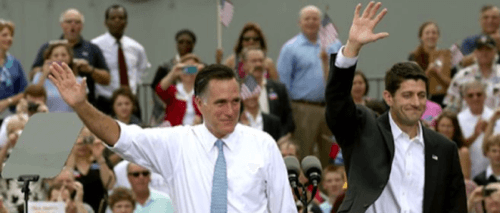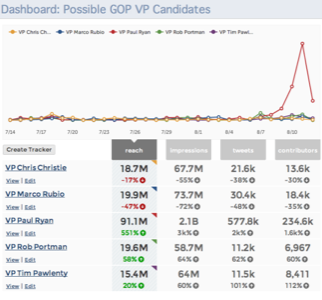
Even as some of the men Mitt Romney considered as a running mate waited for a call from the presumtive Republican presidential candidate, Twitter had already predicted that Paul Ryan would be tapped for the ticket. Here’s how the tweet stream revealed Romney’s secret.
TweetReach, a unit of Internet analytics firm Union Metrics, released data over the weekend suggesting that Twitter was already onto the Romney campaign as early as last Wednesday. The firm tracked what it calls Ryan’s “reach,” defined as total number of impressions, tweets about the candidate and the number of unique contributors. After racking up numbers similar to other likely nominees for the preceding 30 days, Ryan’s reach surged as mainstream media outlets and other politically influential Twitter users began to bandy his name about more fervently.
The analysis suggests that political campaigns operating in the age of social media may struggle to keep secrets that were once carefully orchestrated to coincide with news cycle.
“There’s no question that Twitter rapidly spreads information. The difficult part is determining whether that information simply conveys the preferences of a vocal minority or contains actual knowledge leaked by insiders,” said Union Metrics Chief Executive Hayes Davis. “In cases where a group of insiders – like a VP selection process – aren’t likely to be drowned out by the vocal preferences of the crowd, Twitter can make it very hard to keep a secret.”
In other words, Twitter may have helped make one of the best-kept secrets in this year’s election one of the worst-kept secrets in a matter of hours.
Ryan, along with the other four men most often mentioned as likely Romney running mates (Rob Portman, Tim Pawlenty, Marco Rubio and Chris Christie), maintained fairly steady reach numbers throughout the summer, with the occasional spike when an article or broadcast news report mentioned them.
That chaged Wednesday, when Ryan’s reach surged by 65%, eventually peaking with mentions on 84.3 million unique Twitter accounts on Saturday, the day the announcement was officially made. Ryan had reportedly been informed of Romney’s decision one week earlier, on August 1, but the campaign remained mum until the official announcement on Saturday.

“The reason this is interesting is because…more – and different – people started talking about him [on Wednesday],” Jenn Deering Davis said in an email. “This leads us to think that on Wednesday the word finally started trickling out from those in the know. Romney and Ryan themselves had known the decision for a week by then, and as rumors became more rampant and serious, the political media started hypothesizing.”
Tweets from the Wall Street Journal, The Nation, MSNBC, Politico and The New Yorker – all of which have been covering the election and all of which have large lists of influential Twitter followers – gave Ryan’s name enormous reach on Twitter in the days leading up to the official announcement. Davis said there were only 3,000 unique tweets mentioning Ryan, which would normally translate into reach of about 3 million. In the days between Wednesday and Saturday, however, those 3,000 tweets resulted in a reach of 6 million for the Wisconsin Representative by the time the announcement was made official on Saturday.
Davis said the charts show more about how Twitter can spot leaks and less about its predictive ability, or its ability to influence decision makers.
“Paul Ryan was not chosen because he was the most popular candidate on Twitter (he wasn’t). We already know Twitter isn’t very good at predicting that kind of thing – just look at the GOP presidential selection or the recent Mexican presidential election, where the most popular candidates on Twitter were not the ones who won,” Davis said. “This is not a case of a public decision made by popular opinion. Instead, this is a case of a decision made behind closed doors by experts who were in the know, and the truth slowly but definitively leaked out through the tweets.”










